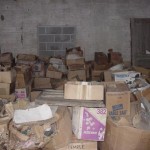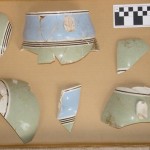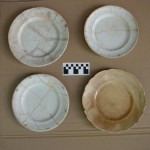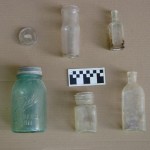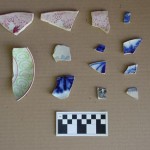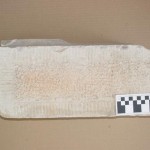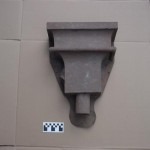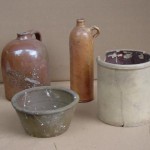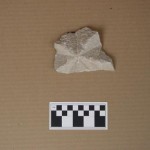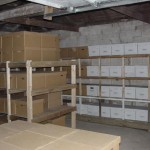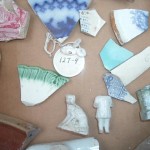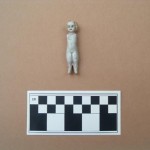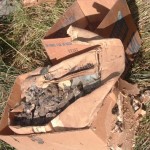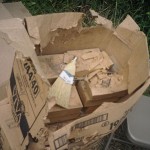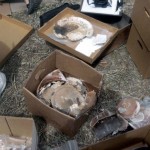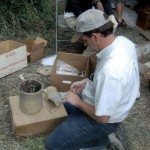Cataloging & Conservation of Nauvoo Temple Artifacts, Nauvoo, Illinois (2004)
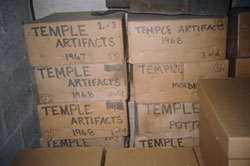
Shane Baker did an extensive cataloging of Nauvoo artifacts from August 9th-13th, 2004. The Mormon Historic Sites Foundation granted approval for funding to be provided to BYU’s Office of Public Archaeology to catalogue and conserve the artifacts from the original Nauvoo Temple. In addition Nauvoo Restoration Incorporated (NRI) gave permission for the study to be conducted.
The results of the project will be published in an upcoming edition of Mormon Historical Studies.
Photos
Articles & Resources
Fragments of Nauvoo history reclaimed after years of neglect
Author(s): Carrie A. Moore
Published in: Deseret Morning News
Publication Date: November 27, 2004

Associated Press
A treasure trove of artifacts left in Nauvoo, Ill., by early members of The Church of Jesus Christ of Latter-day Saints have been reclaimed after years of neglect left them deteriorating in an old shed.
Shane Baker, an archaeologist formerly with Brigham Young University, secured funding from two LDS entities — the Foundation for Ancient Research in Mormon Studies and the Mormon Historic Sites Foundation — to lead a team that cleaned, catalogued and repackaged the items this past summer in Nauvoo.
Among them are not only pieces of the original temple’s baptismal font and floor, fragments of sun stones and moon stones, but items that reflect the everyday life of early Latter-day Saints including silverware, ceramics, fruit and canning jars, medicine bottles, lanterns and even children’s dolls. Such recovered items often help flesh out details about those whose names never appear in any written account, such as women, children and minorities.
First excavated during the 1960s at the site of the original Nauvoo Temple and other historic buildings, the items were boxed and put away for future study, but they apparently fell through the cracks with numerous overseers during the intervening decades.
When Baker and his team got to the site last August, cardboard boxes containing the items — stored inside an old garage — were deteriorating and had become a haven for rodents. “We had to chase a raccoon out of the shed,” Baker remembers. Working with masks and rubber gloves in the summer heat, the team spent a week cleaning, cataloguing, repackaging and boxing the entire collection.
Baker said he became aware of the collection from his work with BYU archaeologist Dale Berge, who knew of its existence after working on the collection after excavations in the 1960s. Spearheaded by Salt Lake physician Leroy Kimball, a descendant of early Nauvoo resident and church leader Heber C. Kimball, the excavation on the site of old Mormon homes and buildings began when Kimball purchased his ancestor’s home, intending to restore it, Baker said.
As he worked, “he was constantly inundated with people stopping by who wanted to see and tour it,” Baker said. As a result, he began a quest to restore historic sites in the small town and formed the nonprofit Nauvoo Restoration Inc. in July 1962, with the objective of restoring historic Nauvoo, Baker said. Kimball and other supporters funded the project early on until the LDS Church stepped in.
Baker said at least 25 different properties in Nauvoo were investigated in addition to the old temple site, including the Browning home and gunsmith shop, the Brigham Young home, the Wilford Woodruff home, Times and Seasons newspaper offices, the Seventies Hall, a bakery and a blacksmith shop. The work was conducted by scholars from both Southern Illinois University and the University of Missouri, Baker said, adding that famed historical archaeologist J.C. Harrington spent several seasons researching in the area as well.
As the project progressed, the bulk of responsibility for cleaning up and conducting research on the excavated objects fell to Berge, Baker said. But Nauvoo Restoration Inc. put its major “emphasis from the very start on restoration of the architecture. That was implicit in their objectives. They wanted to facilitate restoration of the buildings to their period appearance.”
Yet at many sites, the structures had been demolished completely. At that point, reconstruction becomes a work for archaeologists in conjunction with others, Baker said.
“As they dug, they came up with a wonderful collection” of household materials, he said. “Some of them were washed and processed and restored, but there was never much emphasis at the time on analysis and publication of those materials.
“They have an important story to tell and can add lots of insights, but that was not the objective at that time.”
Berge’s work on the excavated items took place at the old Lyon Drug store in Nauvoo, a historic building with modern additions that he used as an archaeological lab, Baker said.
He returned for several summers to work on the project under Nauvoo Restoration supervision, and locking the lab when he left to return the next summer. “NRI at some point decided they were finished, and I think it caught him (Berge) unaware. He didn’t know it would be his last summer,” and Berge was “not present when the artifacts had to be boxed up and moved” while the drugstore was renovated.
After Berge’s work ended, Baker said, the items were “moved three or four times. They resided at some point in a barn and they ended up finally in this shed-like storage structure and just sat there.” Not for just a year or two — but for nearly four decades.
Berge and Baker talked often of the items, and Berge returned to Nauvoo in 2001 to find out what had become of them. He found many had, at one time, been displayed in the restored Seventies Hall, but the rest were languishing uncared for in a shed.
“They were forgotten, essentially,” Baker said, explaining that NRI is now operated by LDS missionaries whose assignments rotate every year to 18 months. The problem with such constant turnover is a lack of real ownership by anyone for supervision of the artifacts.
Yet they have incalculable historical value, Baker said. After talking with Berge, Baker decided to seek funding to recover and organize the collection and went to Nauvoo in the summer of 2002 to complete the first phase of the project. He examined the items, looked in local archives for documentation and tried to piece together what went where.
It was like piecing together a big jigsaw puzzle, and he knew he needed more time. So, he and a team returned last August under the auspices of BYU’s Department of Public Archaeology.
Kim Wilson with the foundation accompanied the team and had an “interesting personal experience — to hold the artifacts from the old temple in the morning and go through a session in the new temple later that day was unique to say the least.”
That trip set the stage for further work, with the goal of making some of the collection available for exhibition at some point, Baker said. Details are pending.
“There are tremendous stories that these things tell. It’s really a history written in stones and bones.”

